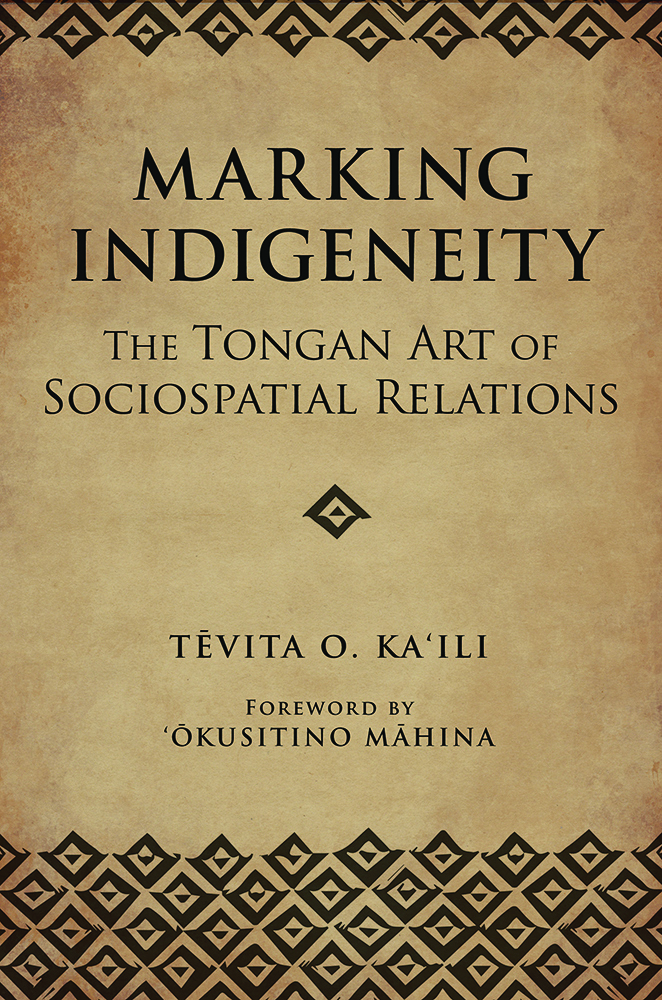Marking Indigeneity
The Tongan Art of Sociospatial Relations
Paperback ($29.95), Ebook ($29.95)
Buy
Tongans, the native people of the Kingdom of Tonga in the South Pacific, are a highly mobile indigenous group. Like their seafaring ancestors, they are constantly on the move across tā (time) and vā (space). Carrying their traditions with them, Tongans living in Maui, Hawai‘i, actively mediate those dimensions by extending the time-space structure of certain activities and places in order to practice tauhi vā—the marking of time to sustain harmonious relations and create beautiful sociospatial relations.
In Marking Indigeneity, Tevita O. Ka‘ili examines the conflicts and reconciliation of indigenous time-space within the Tongan community in Maui, as well as within the time-space of capitalism. Using indigenous theory, he provides an ethnography of the social relations of the highly mobile Tongans.
Focusing on tauhi vā, Ka‘ili notes certain examples of this time marking: the faikava gatherings that last from sunset to sunrise, long eating gatherings, long conversations (talanoa), the all-night funeral wakes, and the early arrival to and late departure from meetings and celebrations. Ka‘ili also describes the performing art of tauhi vā, which creates symmetry through the performance of social duties (fatongia). This gives rise to powerful feelings of warmth, elation, and honor among the performers. Marking Indigeneity offers an ethnography of the extension of time-space that is rooted in ancient Moana oral traditions, thoughtfully illustrating the continuation of these traditions.
In Marking Indigeneity, Tevita O. Ka‘ili examines the conflicts and reconciliation of indigenous time-space within the Tongan community in Maui, as well as within the time-space of capitalism. Using indigenous theory, he provides an ethnography of the social relations of the highly mobile Tongans.
Focusing on tauhi vā, Ka‘ili notes certain examples of this time marking: the faikava gatherings that last from sunset to sunrise, long eating gatherings, long conversations (talanoa), the all-night funeral wakes, and the early arrival to and late departure from meetings and celebrations. Ka‘ili also describes the performing art of tauhi vā, which creates symmetry through the performance of social duties (fatongia). This gives rise to powerful feelings of warmth, elation, and honor among the performers. Marking Indigeneity offers an ethnography of the extension of time-space that is rooted in ancient Moana oral traditions, thoughtfully illustrating the continuation of these traditions.
“An important contribution to decolonizing research methodologies.”—The Contemporary Pacific
“Ka‘ili reiterates the crucial and redressing role of methods and theoretical contributions by indigenous research(ers) through talk, language, and co-production of knowledge with fieldwork participants, all while negotiating that which he is exploring: the co-production of social space.”—Ping-Ann Addo, author of Creating a Nation with Cloth
“A penetrating study of how Tongans conceptualize and enact tauhi va, the maintenance of positive social relationships. This outstanding book will be of interest to readers of cultural anthropology, indigenous studies, and Pacific studies.”—Susan U. Philips, Professor Emerita, University of Arizona
“Ka‘ili reiterates the crucial and redressing role of methods and theoretical contributions by indigenous research(ers) through talk, language, and co-production of knowledge with fieldwork participants, all while negotiating that which he is exploring: the co-production of social space.”—Ping-Ann Addo, author of Creating a Nation with Cloth
“A penetrating study of how Tongans conceptualize and enact tauhi va, the maintenance of positive social relationships. This outstanding book will be of interest to readers of cultural anthropology, indigenous studies, and Pacific studies.”—Susan U. Philips, Professor Emerita, University of Arizona
 The University of Arizona Press
The University of Arizona Press

